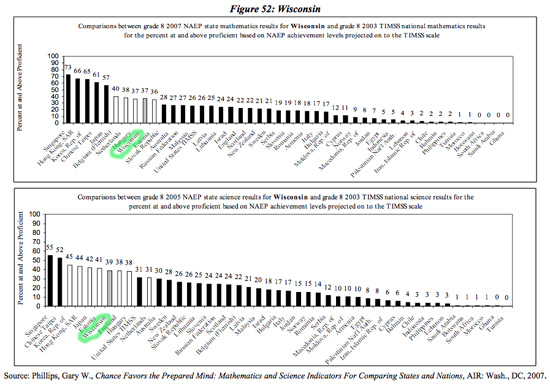U.S. students 'middle of the pack' compared with world

Click for a larger version of this image.
Greg Toppo:
Educators and politicians these days make a point of saying that U.S. schoolchildren aren't just competing locally for good, high-paying jobs — they're competing globally.
A detailed study lets them know just how well kids may do if they really compete globally someday — and it's not exactly pretty.
Crunching the most recent data from a pair of U.S. and international math and science exams for middle-schoolers, Gary Phillips, a researcher at the non-profit American Institutes for Research (AIR), a non-partisan Washington think tank, finds a decidedly mixed picture: Students in most states perform as well as — or better than — peers in most foreign countries.
But he also finds that even those in the highest-scoring states, such as Massachusetts and Minnesota, are significantly below a handful of top-scoring nations such as Singapore, Hong Kong, South Korea, Taiwan and Japan.
1.9MB PDF Report:
In mathematics, students in 49 states and the District of Columbia are behind their counterparts in Singapore, Hong Kong, South Korea, Taiwan and Japan. Students in Massachusetts are on a par with Japanese students, but trail the other four nations. In science, students in Massachusetts, Minnesota, Montana, New Hampshire, North Dakota, South Dakota, Vermont and Wisconsin trail only students in Singapore and Taiwan, while performing equal or better than students in the other 45 countries surveyed.
“More than a century ago Louis Pasteur revealed the secret to invention and innovation when he said ‘chance favors the prepared mind’. The take away message from this report is that the United States is loosing the race to prepare the minds of the future generation,” said Dr. Phillips.
Students in the District of Columbia had the lowest U.S. performance in mathematics (they did not participate in the science test). In math, the average D.C. student is at the Below Basic level, putting them behind students in 29 countries and ahead of those in 14 countries. In science, nine states are at the Below Basic level: Florida, Arizona, Louisiana, Nevada, New Mexico, Alabama, Hawaii, California and Mississippi.
Clusty Search:
National Assessment of Educational Progress (NAEP) |
Trends in International Mathematics and Science Study (TIMMS)
Posted by Jim Zellmer at November 14, 2007 11:41 AM
Subscribe to this site via RSS/Atom:  Newsletter signup | Send us your ideas
Newsletter signup | Send us your ideas


 | Newsletter signup | Send us your ideas
| Newsletter signup | Send us your ideas Newsletter signup | Send us your ideas
Newsletter signup | Send us your ideas